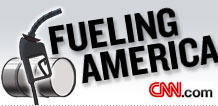|
Betting billions on liquefied natural gas Slacking crude reserves and rising demand are driving what some are calling one of the biggest investment trends in the world. NEW YORK (CNNMoney.com) -- An estimated $30 billion a year is pouring into developing liquefied natural gas. Despite concerns over the safety and the cost of importing it, analysts say the fuel will make up a larger and larger share of America's energy mix and may help prevent seasonal natural gas price spikes.
With high natural gas prices in the United States, some ask whether LNG, which is more expensive to bring to market, can be a long-term competitor to regular natural gas, dollar for dollar. Sheraz Mian, an energy analyst at Zacks Investment Research, paints the LNG challenge this way: "Will natural gas prices remain high enough for these types of projects to earn the returns investors are looking for?" Exxon Mobil (Charts), not a company known for taking chances on unproven technologies, is betting $14 billion they will. Why all the hype? Creating LNG involves cooling normal natural gas to 260 degrees below zero Fahrenheit, sending it around the world in superinsulated ships and then re-gasifying it at its destination. "It's one of the biggest investment trends in the world," said David Talbot, with the energy research firm John H. Herald. "That's what's happening. We're going increasingly from crude oil to natural gas." The reasons for the boom are primarily twofold. The first is that the United States is using more and more natural gas because it's both cleaner burning than oil and economical. Exxon estimates America's consumption of natural gas will rise from 65 billion cubic feet per day (bcfd) currently to 85 bcfd in the next 10 years. But domestic production of natural gas will only increase from about 55 bcfd today to about 60 bcfd. "The difference between production and consumption is increasing," said Exxon spokesman Bob Davis. "That's why you're hearing so much about LNG." Exxon, which along with Royal Dutch Shell is one of the biggest players in the LNG business, is currently embarking on a $14 billion LNG project with Qatar Petroleum and ConocoPhillips (Charts) that will bring LNG into the Texas Gulf Coast. That Texas LNG operation is one of three the company has going worldwide, with others in England and Italy. They will all be fed with gas from a huge field off the coast of Qatar, whose state oil company has a 70 percent stake in the Texas project. Previously much of U.S. natural gas demand was met by Canada, where it was easily shipped south via pipeline. But Canada's natural gas production, like America's, is expected to be flat or slightly declining. Speculation is that Canada will export less natural gas as the country's firms use more of it to extract crude oil from its massive tar sands reserve in Alberta. This growing demand and limited domestic supply, coupled with the fact that under-ocean pipeline construction is not feasible, means there's money to be made by liquefying it (which reduces its volume by 600 times), putting it on a boat and shipping it around the world. The second reason LNG is gaining in popularity is because natural gas reserves held by the big Western oil companies are growing faster than their crude oil reserves. Talbot says the growth rate for natural gas reserves for seven big publicly traded oil companies is running at about 4 percent, while the growth in their crude oil reserves is less than 1 percent. Market stability Consumers could benefit as this natural gas is shipped from places like Qatar, which shares the largest natural gas field in the world, located under the Persian Gulf, with Iran. Because pipelines are not global, natural gas is a regional market. Natural gas is subject to wide price swings whenever a localized event threatens supply, for instance, when natural gas prices in the U.S. spike midsummer in anticipation of hurricane season. But as more and more gas is liquefied and available for worldwide shipping, a shortfall in the United States could easily be covered by sending over supplies from, say, Europe. "It's exciting because it smooths out those spikes in local markets," said Zacks's Mian. While there are currently only five LNG terminals in the U.S., more than 40 are on the drawing board. But many of these won't get built, and it's not just economics blocking the way. Finding a place to build an LNG terminal is a challenge because many people are afraid of a massive explosion if a plant were built near their homes. Industry officials point to an impressive safety record. Bill Cooper, the executive director of the Center for Liquefied Natural Gas, says that, in the 45 years LNG has been transported by boat, there has never been a spill involving an LNG ship. He also notes that the contents are not under pressure, and it would take a rare combination of events to cause an explosion. Nonetheless, an explosion is theoretically possible, and that prospect has made locating LNG facilities a particularly tough sell. But experts point out they don't need to be built near populated areas - indeed, one of the country's five LNG ports currently sits 80 miles offshore in the Gulf of Mexico. _____________________________ |
|


